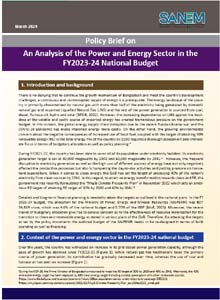
Effects of Inflation on the Livelihoods of Poor Households in Bangladesh: Findings from SANEM’s Nationwide Household Survey 2023 (November-December 2020)
 Citation: Raihan, S., Ahmed, M. T., Hasan, E., Hasan, M., & Surid, T. F. (2023). Effects of Inflation on the Livelihoods of Poor Households in Bangladesh: Findings from SANEM’s Nationwide Household Survey 2023. SANEM Publications, Dhaka, Bangladesh.
Citation: Raihan, S., Ahmed, M. T., Hasan, E., Hasan, M., & Surid, T. F. (2023). Effects of Inflation on the Livelihoods of Poor Households in Bangladesh: Findings from SANEM’s Nationwide Household Survey 2023. SANEM Publications, Dhaka, Bangladesh.
The global supply chain has been severely disrupted as a result of the Russia-Ukraine war, hampering production and trade, leading to a catastrophic fuel and food shortage. As a result, prices have skyrocketed for everything from food to non-food items. This crisis has had a catastrophic impact on various countries, including Bangladesh, where low-income groups have been particularly affected. As estimated by BBS, the annual inflation rate in Bangladesh increased from 6.17% in February 2022 to 8.78% in February 2023. In several months during this period, it exceeded 9%. SANEM’s work on inflation raises worries that the actual inflation rate might be higher for low-income individuals. However, along with the escalated prices of food, fuel, and commodities in the global market, domestic production shortages, supply-side disruptions, local market imperfections and anomalies, and currency depreciation are also contributing to the recent soaring inflation.
Against this backdrop, this study aims to investigate the effect of inflation on the livelihoods of poor households in Bangladesh. It also attempts to explore the coping strategies and future outlooks of poor households in response to high inflation. By surveying a representative sample of 1600 poor households across eight divisions of the country, the study intends to shed light on the impact of inflation on income, expenditure patterns, food habits, food security, borrowing behaviour, and future outlooks of these households.
The survey was conducted between March 9 and 18, 2023, targeting 800 urban and 800 rural households. For each of the eight divisions, 200 surveys were carried out, involving 100 urban and 100 rural households. Urban households were chosen from the slums of city corporations in each divisional headquarters. Except for the divisional Upazila in the divisional district, rural households were identified based on a randomly identified Upazila. Within the identified Upazilas, four villages were chosen, and households were randomly selected based on their dwelling types. The survey collected data on various parameters, including household characteristics, income, expenditure, food habits, coping strategies, food security, social security coverage, and perceptions of the government’s measures to address inflation.
The study found that, between September 2022 and February 2023, the monthly average household income remained the same, while the monthly average household expenditure increased by 13.1%. Although there was no significant change in monthly household income for both rural and urban areas, the monthly average household expenditure witnessed a significant rise at the national level. The expenditure on food items increased more in urban areas, while expenditure on non-food items increased more in rural areas. The survey also highlighted that poor households resorted to coping strategies such as changing food habits, consuming lower-quality food, reducing non-food expenditures, and borrowing. Additionally, food insecurity among poor households increased significantly, with a decline in access to healthy and nutritious food.
Given the findings, the study recommends several policy measures to address the challenges faced by poor households in the context of inflation and food insecurity. These include controlling price increases, improving supply chain management, increasing domestic food production, finding alternative import sources, ensuring affordable prices for food items, strengthening market monitoring, expanding social security programs, promoting financial education, increasing access to affordable credit, and enhancing government measures to mitigate inflationary pressures. Implementing these policies can provide relief to poor households, alleviate food insecurity, and improve their overall livelihoods in the face of inflationary challenges.



